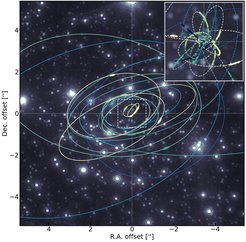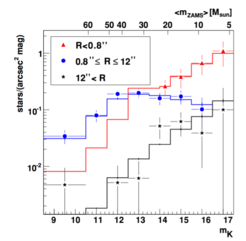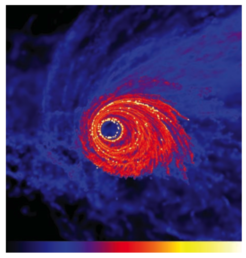The Young Stars in the Galactic Center

At larger distances (r > 1 arcsec), we find another population of stars: even more massive, even younger O- or WR-type stars than the S-stars in the central arcsecond. A large fraction of these stars moves coherently, the most prominent feature being a warped disk formed by the stars moving clockwise (Paumard et al. 2006, Bartko et al. 2009, von Fellenberg 2022).
Typically, we cannot detect the weak accelerations anymore at these radii. With 2D positions, proper motion, and radial velocity, we can measure only five dynamic quantities, where six would fully determine the orbit. However, taking an ensemble of stars, we can show in a statistical sense that a large fraction of them moves in a disk. The following plot is the same projection as for the S-stars, and shows the probability distribution of the angular momentum vector as constrained by the dynamic data of the young, massive stars between 1 arcsecond < r < 3.5 arcseconds and with a brightness of mK < 14.5. One can see the (significant) overdensity defining the clockwise stellar disk. Furthermore, we have been able to detect accelerations for 15 of these stars, which allows us to determine complete orbital solutions. All of them explicitly turn out to be members of the clockwise disk.

Furthermore, we have shown that the IMF of these massive young stars is top-heavy (Bartko et al. 2010, von Fellenberg et al. 2022).
The stars in the clockwise disk are even younger than the S-stars. Yet, their formation history appears to be solved: they formed roughly six million years ago from a massive (around 100,000 solar masses) molecular cloud falling into the Galactic Center. Simulations show that the gas will circularize and form stars in a very unusual mode. The simulations demonstrate that such an event will result in the observed disk structure, top-heavy mass function, and density profile. The relation (if there is any) between the disk-like features at r > 1arcsecond and the S-stars in the central arcsecond is a topic of active research.





